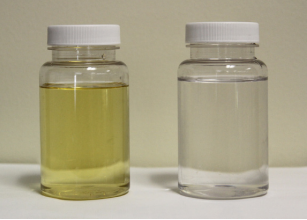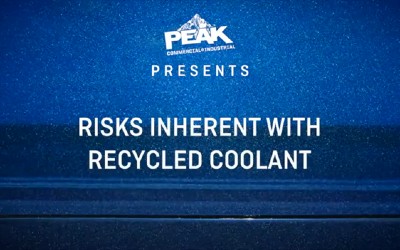
Critical Issues Impact Value of Recycled Antifreeze Products
- White Papers
- FINAL CHARGE, FLEET CHARGE, Full Force
- May 17, 2017
Recycled coolants drive concerns around efficacy and the potential threat to engine cooling systems. Through the decades, as raw material costs increased, recycled and green products have grown in popularity and have been continually developed and created as a more economical and environmental alternative.
In the transportation industry, as the cost for ethylene glycol (EG), the primary raw material in antifreeze rose, new recycled options were introduced to the market to combat higher prices. There are several methods used to recycle antifreeze including filtration, ion exchange, reverse osmosis and distillation. All methods attempt to remove impurities and degradation products that have accumulated over time and which render used coolant corrosive. However, many experts have raised questions and concerns around the efficacy of these recycled coolant alternatives, several of which are detailed below.
All available recycled methods have limitations and in order to understand these limitations, we must consider the most common impurities and the threat they pose to the engine’s cooling system.
Recycled Antifreeze Impurities
- Solid debris: Over time, a used coolant will accumulate solid debris from spent corrosion inhibitors such as silicate and phosphate. These solids are abrasive and will shorten the life of the system’s water pump and erode the soft metals in the heater core and radiator.
- Supplemental coolant additive: Supplemental coolant additive (SCA) are often added to replace spent inhibitors. Over the years, continued SCA addition can lead to very high levels of total dissolve solids; while not corrosive themselves, spent SCA will eventually drop out and contribute to the solid debris that damages water pumps, radiators and heater cores.
- Glycolic and formic acids: As used coolant ages, glycol degrades to corrosive glycolic and formic acids. As these acids accumulate in the coolant, they will attack and corrode ferrous metals. • Chlorine content: As coolant evaporates and is topped off with chlorinated tap water, chlorine content will rise and like glycolic and formic acid, will attack iron components.
- Oils: Oils (and other organics) from leaking gaskets and seals may contaminate used coolant. Even small amounts of oil will coat cooling system walls, preventing corrosion inhibitors from doing their job. While testing may reveal acceptable inhibition, in effect, there will be no protection due to the oil barrier.
For glycol to be reused, each of these contaminants must be effectively removed. If not, the coolant prepared from the recycled fluid will either be corrosive itself rather than providing corrosion protection, or it will have a greatly reduced use life before contaminants again reach dangerous levels.
So how effective are the recycle methods at lowering or removing these impurities?
Antifreeze Recycling Methods
Filtration: Recycling units – especially those units that allow a maintenance shop to recycle on location – often rely on filtration to remove impurities. Filtration is the cheapest but also worst process for recycling. Filtration will remove solid debris and may lower oil contamination but dissolved impurities will still pass through even the finest of filters. A coolant high in total dissolved solids, chloride, glycolate and formate will remain high in these corrosive components even after filtration. Trace oil emulsions may also remain and this oil will compete with inhibitors for cooling system surfaces preventing effective corrosion inhibition. The final product may look good after the process, but still should not be considered free and clear of impurities.
Ion Exchange: Resins replace dissolved ions with water. As such they can lower chloride, glycolate and formate to safe levels in a used coolant. However, the ion exchange resin beds may allow abrasive solids to pass through. Furthermore, ion exchange beds are not effective at removing non-ionic contaminants such as oil. Because of this, ion exchange beds must be regenerated and carefully monitored as their efficiency decreases with use. This process deserves careful attention, as a spent resin bed is even more contaminated than the above filtration process.
Some recyclers use a combination process where spent coolant is run through a series of filters and ion exchange resins. The combination has the potential to remove solid debris and dissolved ionic material, but dissolved non-ionic impurities and oil emulsions will evade removal. It is important to note that no original equipment manufacturers (OEM) recognize this type of recycled coolant as acceptable for use in their vehicles.
Reverse Osmosis: This process uses pressure to force glycol and water through a membrane, leaving ionic materials, dissolved organic compounds and solids behind. True reverse osmosis can produce pure glycol water solutions. However, the process is incapable of handling used glycol streams containing emulsified oils. While oil will not penetrate the membrane, it will effectively coat the membrane and shut the process down. The process can not be used to make coolant concentrates as it will not fully separate water from the recycled glycol. Only pre-diluted coolants can be made using reverse osmosis and again, even this can only be accomplished where the possibility of oil contamination is absent.
Distillation: Distillation is the only process that can produce a coolant concentrate. A preferred method, the distillation process separates the glycol from the other components in the used coolant. Dissolved ionic material will not distill over with the glycol; neither will suspended solids. Oil and oil emulsions will be separated as well if the distillation conditions are carefully monitored and controlled.
However, even distillation has potential problems. Some dissolved ionic materials such as chloride, formate and glycolate, and the corrosion inhibitors nitrite and nitrate, will distill if the used coolant pH is not adjusted prior to distillation. Only large facilities with on-site analytic capabilities can assure the proper adjustments are made and that carry over is avoided.
In summary, all methods of recycling have their problems. If it were possible to select a recycle process or processes to match the batch of used coolant that is being treated, a purified glycol stream could be obtained with the appropriate selection. However, recyclers do not have all these processes at hand from which to choose the optimum for the job. Moreover, the recycling is done in batch mode and impurities vary from batch to batch. The recycler would need to perform a detailed analysis on each batch and then choose the appropriate method for that batch. Therefore, the recycler is married to the particular chosen method and its inherent limitations.
Because of the limitations associated with the available recycling processes, using coolants consisting of virgin glycol containing new, raw materials is a reliable way to ensure optimal cooling system performance. PEAK FINAL CHARGE® Global Extended Life Coolant/Antifreeze uses only virgin glycol inputs to guarantee reliable performance, extend service intervals and reduce service and maintenance costs.
The American Society of Testing and Materials (ASTM)
Position For more than a decade, the ASTM has tried to deal with generating standards that apply to recycled coolant. The governing standard for coolant is ASTM D3306. Since recycled antifreeze products typically cannot meet this standard, manufacturers for years wanted the standard’s quality requirements reduced so their coolants could meet it. The ASTM committees would not agree to this, so instead there are ‘relaxed’ standards, ASTM D6471 and D6472, for recycled coolants.
However, even if a recycled coolant can meet the ASTM specifications, the concern is how that coolant will perform over time. Although these standards have accelerated corrosion tests, there are no standards specifically correlated to coolant life.


